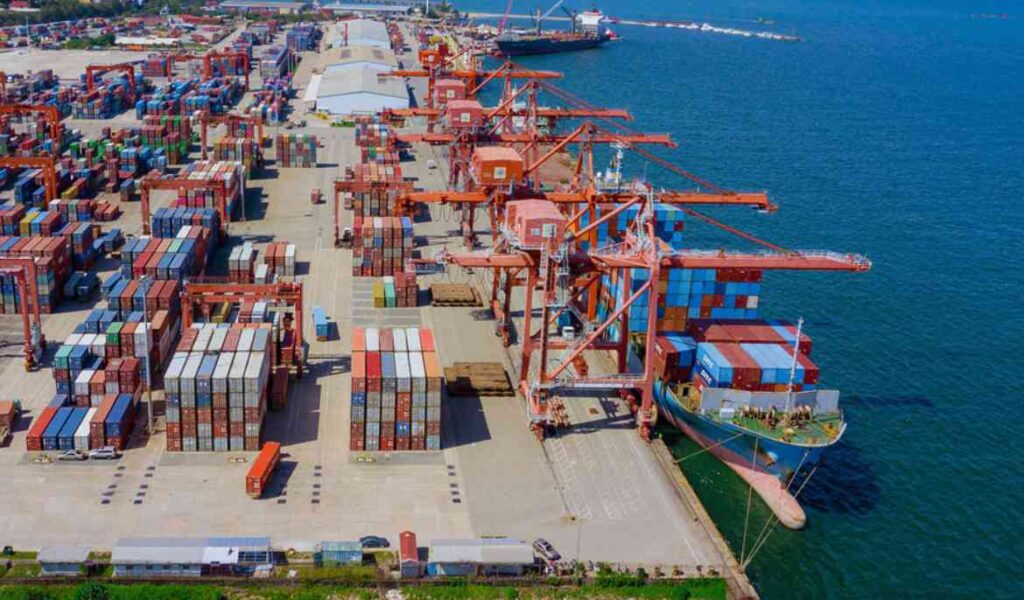The number of containers passing through Sihanoukville Autonomous Port (PAS) in the third quarter of the year reached nearly 300,000 twenty-foot equivalent units (TEUs), an almost 40% increase compared to the third quarter of 2023.
According to the PAS Q3 2024 report, published on November 19, this means the port company has increased its revenue by less than the TEU throughput, although it has reduced its net loss over previous figures.
Container throughput amounted to 283,918 TEUs, an increase of 76,011, equal to a 36.56% increase over Q3 in 2023.
In Q3, the port saw revenues of 120 billion riel (about $30 million), an increase of 27% over Q3 in 2023.
Net losses after tax fell by 29 billion riel (around $7 million), a 135.63% drop over the same period in 2023.
These results saw PAS shares drop by 91.38 riel per share in Q3.
At the end of Q3, PAS also inaugurated a new container terminal, which is expected to boost export and import capacity.
“PAS will continue its efforts to improve its business and service operations and achieve the best results for our shareholders. PAS has strengthened work efficiency and built additional infrastructure to meet the increasing demand of customers and the Kingdom’s growing economy,” said Lou Kimchhun, PAS chairman and CEO.
An additional container terminal, equipped with modern lifting equipment, was inaugurated by Prime Minister Hun Manet on September 12. The new terminal represents a major upgrade for a 350 metre wharf which was constructed in 1969.
At present, the PAS has three operational terminals.
Construction of the first phase of a new deep-water container port began last December and is expected to be completed by 2025. With a length of 350 metres and depth of 14.50 metres, it will allow larger container vessels, with a capacity of up to 60,000 deadweight tonnage (DWT) (approximately 4,000 TEUs), to dock at the port.
The project is expected to be completed by mid-2027. The port’s annual container handling capacity will reach 1,250,000 TEUs when the new terminal is launched.
Chea Chandara, president of the Logistics and Supply Chain Business Association in Cambodia (LSCBA), told The Post on November 20 that the increase in containers passing through the port indicates growth in Cambodia’s manufacturing sector and the national economy as a whole. The volume of cargo at PAS is expected to continue rising as Cambodia attracts increasing foreign and domestic investment to enhance its export capacity.
“Cambodia is currently known as a manufacturing hub for various products which serve the needs of global markets. Therefore, imports of raw materials and components for production and exports of finished goods will continue to increase in the future,” he explained.
He believed that modernisation and the expansion of the port will have significant positive impacts on Cambodia’s economic growth by improving the country’s logistics sector, reducing congestion and lowering transportation costs.
According to Chandara, the majority of the Kingdom’s imports consist of raw materials from China and neighbouring countries, while exports are predominantly finished products which are sent to distant markets like the US, Canada and Europe.
Statistics from the General Department of Customs and Excise of Cambodia (GDCE), published on November 11, revealed that from January to October, Cambodia’s total trade volume with all partner countries reached $45.06 billion, up 16.5% compared to the same period in 2023, which amounted to $38.67 billion. Of this, exports were valued at $21.57 billion, up 16% from $18.59 billion, while imports totalled $23.49 billion, an increase of 16.5% from $20.07 billion.



